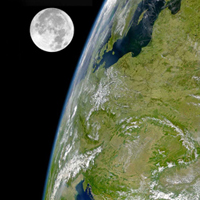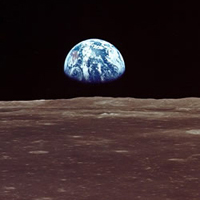|
Welcome to the STEREO Learning Center
A Scale Model of the Solar System using Play-doh!
An Activity for:
Prepared by Jacob Noel-Storr
Download this activity in
PDF format
Materials
- 3lbs of Play-doh (minimum quantity of Play-doh required for this activity)
- Paper
- Pens
- Rulers
Activity procedures | EARTH - MOON
Have students predict and make models of the size and distance of the MOON in relation to
the EARTH. Divide the Play-doh into 50 equal sized balls (as equal as possible). Choose an average sized
ball and set it aside. Squash the other 49 back together. You now have the EARTH and MOON. Now comes the relative distance. The distance between the EARTH and the MOON should be equal
to 30 EARTH diameters. Have students compare their original model with the scale model they just created. Get them
to think about why they thought that before. (NOTE: the misconception of the relative size
and distance between the EARTH and the MOON is due to perspective which comes from the
photographs we have all seen of both. In order to get both the EARTH and the MOON in the same
photo, one has to take a photo of them one in front of the other and slightly off to one side.
 View of the Moon from and orbit around the Earth
View of the Moon from and orbit around the Earth
 View of the Earth from the surface of the moon
View of the Earth from the surface of the moon
EARTH - MOON - MARS
Divide your Play-doh in half. One half is the EARTH. Make seven balls out of the other half. One ball is MARS. Take another one of the seven balls and divide it into seven. One of those is the MOON. You can also do scales with this model...but MARS is far! If you used 3lbs of Play-doh for
this model, the distance between EARTH and MARS would be 7 city blocks!
SOLAR SYSTEM
-
Write the name of each of the nine planets on separate pieces of paper. Spread the
labeled papers out on a table. This is where you will be placing the Play-doh to make each of
the planets.
Make 10 equal balls. Squash 6 of them together...this will be JUPITER. Place the ball on the
paper labeled JUPITER. Take another 3 and squash them together...this is only part of SATURN
(you will add to SATURN two more times before the activity is over). Place the ball on the
paper labeled SATURN. Divide the ball of Play-doh that is left into 10. Squash 5 of them together and add them to
SATURN. Take 2 and squash them together...this is NEPTUNE. Place the ball on the
paper labeled NEPTUNE. Take another 2 and squash them together...this is URANUS. Place the
ball on the paper labeled URANUS. With the ball that is left, make 10 equal sized balls. Squash 9 of them together...add them
to SATURN. SATURN is now complete! Divide the remaining ball into 2. 1 is EARTH. Place the ball on the paper labeled EARTH. Now is when things get tricky! Divide the ball that is left into 10. 9 of them make up
VENUS. Place the ball on the paper labeled VENUS. Make 10 balls out of the 1 that is left. Use 9 to make create MARS. Place the ball on the
paper labeled MARS. Divide the ball of Play-doh that is left into 10. 9 of them make up MERCURY (Place them on the
paper labeled MERCURY) and the one left is PLUTO! Place the ball on the paper labeled PLUTO.
Why isn't the Sun included in this activity? The Sun is so much larger than all of the planets that if you use a 3lb tub of Play-doh to make the 9 planets, it would take 980 tubs to make the Sun!
Last Revised: Tuesday, 08-Feb-2022 15:28:19 UTC
Responsible NASA Official: ![[email address: Therese.A.Kucera<at>nasa<dot>gov]](/img/kucera_email1.jpg)
Accessibility
Privacy Policy and Important Notices
Feedback and comments: webmaster
|